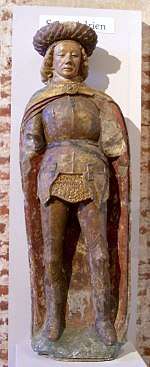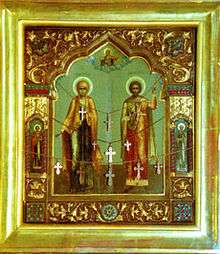Adrian and Natalia of Nicomedia
Adrian of Nicomedia (also known as Hadrian) or Saint Adrian (died 4 March 306)[2] was a Herculian Guard of the Roman Emperor Galerius Maximian. After becoming a convert to Christianity with his wife Natalia, Adrian was martyred at Nicomedia in Turkey.[2] Hadrian was the chief military saint of Northern Europe for many ages, second only to Saint George, and is much revered in Flanders, Germany and the north of France.
Adrian and Natalia of Nicomedia | |
|---|---|
 Saint Adrian and his wife, Saint Natalia | |
| Martyrs | |
| Died | 4 March 306 Nicomedia[1] |
| Venerated in | Roman Catholic Church Coptic Orthodox Church Eastern Orthodox Church |
| Major shrine | Argyropolis near Constantinople; Geraardsbergen, Belgium; Church of Sant'Adriano al Foro, Rome[2] |
| Feast | 8 September (historic Julian calendar) 26 August (Revised Julian calendar)[3] 1 December[4] |
| Attributes | depicted armed, with an anvil in his hands or at his feet |
| Patronage | plague, epilepsy, arms dealers, butchers, guards, soldiers |
Martyrdom

Adrian and Natalia lived in Nicomedia during the time of Emperor Maximian in the early fourth century.[3] The twenty-eight-year-old Adrian was head of the praetorium.
It is said that while presiding over the torture of a band of Christians, he asked them what reward they expected to receive from God. They replied, "Eye hath not seen, nor ear heard, neither have entered into the heart of man, the things which God hath prepared for them that love him."[5] He was so amazed at their courage that he publicly confessed his faith, though he had not yet been baptized. He was then immediately imprisoned. He was forbidden visitors, but accounts state that his wife Natalia came to visit him, dressed as a boy, to ask for his prayers when he entered Heaven.[6]
The executioners wanted to burn the bodies of the dead, but a storm arose and quenched the fire.[7] Natalia recovered one of Adrian's hands.
Historicity
The accuracy of the recorded story has been questioned. A second Hadrian, is said to have been a son of the Emperor Probus, and, having embraced Christianity, to have been put to death (A.D. 320), at Nicomedia in Asia Minor, by the Emperor Licinius. But no reliable information concerning him is extant. He is commemorated on August 26.[8]
Feast day and patronage

In the Eastern Orthodox Church, Saint Hadrian shares a feast day with his wife on 26 August (Revised Julian calendar and/or Gregorian calendar), or on 8 September (most Orthodox Churches still use the historic Julian calendar); he also has feast days alone on 4 March. In the Roman Catholic Church, he is venerated alone, without his wife, on September 8.[9] The Coptic Orthodox Church likewise venerates St. Adrian and his companions on the third day of the Coptic month known as Nesi (corresponding to September 8), mentioning his wife's role during the Synaxarion reading of that day; spelling in the Coptic Synaxarion (likely a result of translating from Arabic to English) yields the names Andrianus and Anatolia.
Saint Hadrian was the chief military saint of Northern Europe for many ages, second only to Saint George, and is much revered in Flanders, Germany and the north of France. He is usually represented armed, with an anvil in his hands or at his feet.
| Wikimedia Commons has media related to Saint Adrian. |
See also
- Saint Adrian or Hadrian of Nicomedia, patron saint archive
References
- Jones, Terry. "Adrian of Nicomedia". Patron Saints Index. Archived from the original on 1 January 2008. Retrieved 2007-12-29.
- Kirsch, J.P. (1910). "Hadrian". The Catholic Encyclopedia. 7. Robert Appleton Company. Retrieved 2007-12-29.
- "St. Natalia, Martyr", Antiochian Orthodox Christian Archdiocese
- Holweck, F. G. (1924). A Biographical Dictionary of the Saints. St. Louis: B. Herder Book Co.
- 1 Corinthians 2:9
- "St. Adrian". Catholic Online Saints & Angels. Archived from the original on 3 March 2008. Retrieved 2008-03-04.
- "Martyr Adrian of Nicomedia", Orthodox Church in America
- Monks of Ramsgate. “Hadrian”. Book of Saints, 1921. CatholicSaints.Info. 22 May 2017

- Martyrologium Romanum (Libreria Editrice Vaticana, 2001 ISBN 88-209-7210-7)
Further reading
- Attwater, Donald and Catherine Rachel John (1993). The Penguin Dictionary of Saints (3rd ed.). New York: Penguin Books. ISBN 0-14-051312-4.
- Greene, E. A. (1908). "S. Adrian". Saints and Their Symbols: A Companion in the Churches and Picture Galleries of Europe. p. 32. OCLC 16907745.